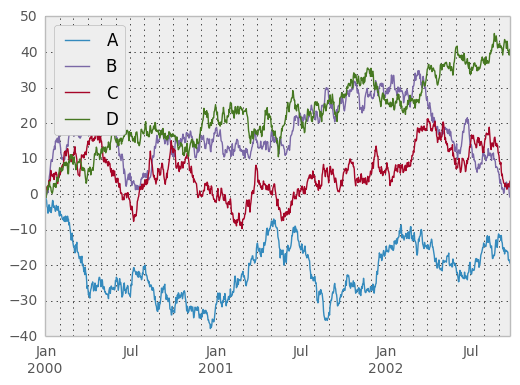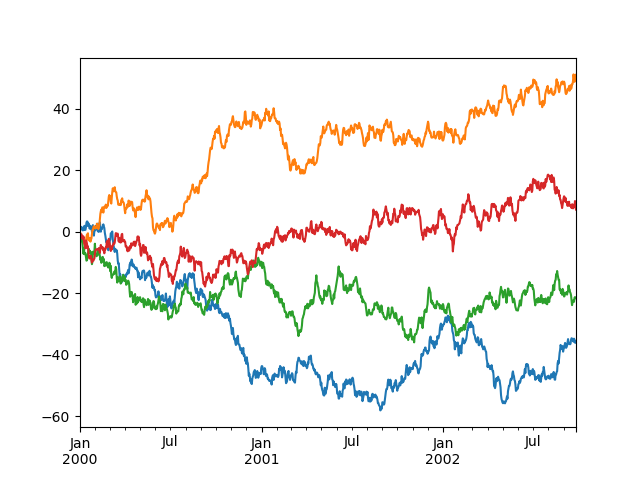44 pandas series get labels
pandas.Series.plot — pandas 1.4.2 documentation pandas.Series.plot ¶ Series. plot (* args ... In case subplots=True, share y axis and set some y axis labels to invisible. layout tuple, optional (rows, columns) for ... Modifying a Series in-place | Learning pandas - Second Edition The value at a specific index label can be changed in place by assignment: Rows can be removed from a Series by passing their index labels to the del () function. The following demonstrates removal of the row with the index label 'a': To add and remove items out of place, you use pd.concat () to add and remove using a Boolean selection.
Python | Pandas Series.get() - GeeksforGeeks Feb 13, 2019 · Pandas series is a One-dimensional ndarray with axis labels. The labels need not be unique but must be a hashable type. The object supports both integer- and label-based indexing and provides a host of methods for performing operations involving the index.

Pandas series get labels
Python Pandas Series - Python Examples Pandas Series. Pandas Series is a one-dimensional labeled, homogeneously-typed array. You can create a series with objects of any datatype. Be it integers, floats, strings, any datatype. You can have a mix of these datatypes in a single series. In this tutorial, we will learn about Pandas Series with examples. Pandas Series Attributes - AlphaCodingSkills Series attributes reflect information that is intrinsic to the series. Accessing a series through its attributes allows us to get the intrinsic properties of the series. Most commonly used attributes are mentioned below: Function. Description. Series.dtype. Return the dtype object of the underlying data. Series.empty. pandas.Series — pandas 1.4.2 documentation pandas.Series — pandas 1.4.2 documentation pandas.Series ¶ class pandas.Series(data=None, index=None, dtype=None, name=None, copy=False, fastpath=False) [source] ¶ One-dimensional ndarray with axis labels (including time series). Labels need not be unique but must be a hashable type.
Pandas series get labels. Python | Pandas Series.drop() - GeeksforGeeks Feb 15, 2019 · Pandas series is a One-dimensional ndarray with axis labels. The labels need not be unique but must be a hashable type. The object supports both integer- and label-based indexing and provides a host of methods for performing operations involving the index. Pandas Series.drop() function return Series with specified index labels removed. It ... A Practical Introduction to Pandas Series | by B. Chen ... A practical introduction to Pandas Series (Image by Author using canva.com). DataFrame and Series are two core data structures in Pandas.DataFrame is a 2-dimensional labeled data with rows and columns. It is like a spreadsheet or SQL table. Series is a 1-dimensional labeled array. It is sort of like a more powerful version of the Python list.Understanding Series is very important, not only ... python - How to print x-axes labels in pandas.Series.plot ... For that purpose, I use the below and get desired output -. df.groupby ('owner_team').inc_subj.count ().plot.bar (ylim=0) Output - My concern is the x-axes labels are shown as numbers, which is the exactly values present. But, my desire is to see the names (string values) corresponding to those numbers. To give a little bit of background ... How to get the index and values of series in Pandas? A pandas Series holds labeled data, by using these labels we can access series elements and we can do manipulations on our data. However, in some situations, we need to get all labels and values separately. Labels can be called indexes and data present in a series called values. If you want to get labels and values individually.
how to Access the elements of a Series in python - pandas ... Accessing data from series with Labels or index: A Series is like a fixed-size dictionary in that you can get and set values by index label. Retrieve a single element using index label: # create a series import pandas as pd import numpy as np data = np.array(['a','b','c','d','e','f']) s = pd.Series(data,index=[100,101,102,103,104,105]) print s ... pandas.Series.loc — pandas 1.4.2 documentation pandas.Series.loc ¶ property Series.loc ¶ Access a group of rows and columns by label (s) or a boolean array. .loc [] is primarily label based, but may also be used with a boolean array. Allowed inputs are: A single label, e.g. 5 or 'a', (note that 5 is interpreted as a label of the index, and never as an integer position along the index). Python | Pandas Series.keys() - GeeksforGeeks Example #1: Use Series.keys () function to return the index labels of the given series object. # importing pandas as pd import pandas as pd # Creating the Series sr = pd.Series ( [10, 25, 3, 25, 24, 6]) # Create the Index index_ = ['Coca Cola', 'Sprite', 'Coke', 'Fanta', 'Dew', 'ThumbsUp'] # set the index sr.index = index_ # Print the series 7 Reindexing and altering labels — Pandas Doc 7 Reindexing and altering labels. reindex() is the fundamental data alignment method in pandas. It is used to implement nearly all other features relying on label-alignment functionality. To reindex means to conform the data to match a given set of labels along a particular axis. This accomplishes several things:
Python Tryit Editor v1.0 - W3Schools Change Orientation. Privacy policy and Copyright 1999-2022 Python Pandas - Series - Tutorialspoint A Series is like a fixed-size dict in that you can get and set values by index label. Example 1 Retrieve a single element using index label value. Live Demo import pandas as pd s = pd.Series( [1,2,3,4,5],index = ['a','b','c','d','e']) #retrieve a single element print s['a'] Its output is as follows − 1 Example 2 Python Pandas Series - javatpoint Python Pandas Series. The Pandas Series can be defined as a one-dimensional array that is capable of storing various data types. We can easily convert the list, tuple, and dictionary into series using "series' method. The row labels of series are called the index. A Series cannot contain multiple columns. It has the following parameter: Indexing and selecting data — pandas 1.4.2 documentation Integers are valid labels, but they refer to the label and not the position. The .loc attribute is the primary access method. The following are valid inputs: A single label, e.g. 5 or 'a' (Note that 5 is interpreted as a label of the index. This use is not an integer position along the index.). A list or array of labels ['a', 'b', 'c'].
Pandas Lesson 1: Series - Practical Data Science Indices¶. One of the fundamental differences between numpy arrays and Series is that all Series are associated with an index.An index is a set of labels for each observation in a Series. If you don't specify an index when you create a Series, pandas will just create a default index that just labels each row with its initial row number, but you can specify an index if you want.
Convert Pandas Series to a List - Data Science Parichay There are a number of ways to get a list from a pandas series. You can use the tolist () function associated with the pandas series or pass the series to the python built-in list () function. The following is the syntax to use the above functions: # using tolist () ls = s.tolist() # using list () ls = list(s)
How to get the names (titles or labels) of a pandas data ... Examples of how to get the names (titles or labels) of a pandas data frame in python. Summary. Get the row names of a pandas data frame; Get the row names of a pandas data frame (Exemple 1) ... Get the row names of a pandas data frame (Exemple 2) Another example using the csv file train.csv ...
Pandas Select Rows by Index (Position/Label) - Spark by ... Use pandas.DataFrame.loc [] to Select Rows by Index Labels By using pandas.DataFrame.loc [] you can select rows by index names or labels.
How to Change Column Labels in Pandas DataFrame? - Python In this tutorial, we shall learn how to rename column labels of a Pandas DataFrame, with the help of well illustrated example programs. Syntax The syntax to assign new column names is given below. dataframe.columns = new_columns The new_columns should be an array of length same as that of number of columns in the dataframe.
Python | Pandas Series - Tutorialspoint.dev Python | Pandas Series. Pandas Series is a one-dimensional labeled array capable of holding data of any type (integer, string, float, python objects, etc.). The axis labels are collectively called index. Pandas Series is nothing but a column in an excel sheet. Labels need not be unique but must be a hashable type.
Labeling Data with Pandas. Introduction to Data Labeling ... We can use the Pandas '.loc []' method to assign ternary labels to the data, which would segment the data into three groups. The label of '0' will be assigned to values (4-7), '1' will be assigned to values (7-9), and '2' will be assigned to values (9-16):
pandas.Series.loc — pandas 0.25.0.dev0+752.g49f33f0d ... Access a group of rows and columns by label (s) or a boolean array. .loc [] is primarily label based, but may also be used with a boolean array. Allowed inputs are: A single label, e.g. 5 or 'a', (note that 5 is interpreted as a label of the index, and never as an integer position along the index). A list or array of labels, e.g. ['a', 'b', 'c'].
Pandas Get Column Names from DataFrame - Spark by {Examples} You can get the column names from pandas DataFrame using df.columns.values, and pass this to python list() function to get it as list, once you have the data you can print it using print() statement. I will take a moment to explain what is happening on this statement, df.columns attribute returns an Index object which is a basic object that ...
Python Tryit Editor v1.0 - W3Schools Run Get your own website Result Size: 497 x 414. ... x . import pandas as pd a = [1, 7, 2] myvar = pd. Series (a, index = ["x", "y", "z"]) print (myvar) x 1 y 7 z 2 dtype: int64 ...
python - Pandas: Get label for value in Series Object ... Pandas: Get label for value in Series Object. Ask Question Asked 9 years ago. Modified 9 years ago. Viewed 22k times 18 2. How is it possible to retrieve the labe of a particular value in a pandas Series object: For example: labels = ['a', 'b', 'c', 'd', 'e'] s = Series (arange(5) * 4 , labels) ...
Pandas Series: idxmax() function - w3resource Get the row label of the maximum value in Pandas series . The idxmax() function is used to get the row label of the maximum value. If multiple values equal the maximum, the first row label with that value is returned. Syntax: Series.idxmax(self, axis=0, skipna=True, *args, **kwargs) Parameters:
Pandas Series: drop() function - w3resource The drop () function is used to get series with specified index labels removed. Remove elements of a Series based on specifying the index labels. When using a multi-index, labels on different levels can be removed by specifying the level. Syntax:
pandas.Series — pandas 1.4.2 documentation pandas.Series — pandas 1.4.2 documentation pandas.Series ¶ class pandas.Series(data=None, index=None, dtype=None, name=None, copy=False, fastpath=False) [source] ¶ One-dimensional ndarray with axis labels (including time series). Labels need not be unique but must be a hashable type.










Post a Comment for "44 pandas series get labels"